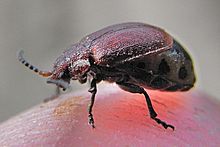Hawthorn leaf beetle
| Hawthorn leaf beetle | ||||||||||||
|---|---|---|---|---|---|---|---|---|---|---|---|---|

Hawthorn leaf beetle on fingertip |
||||||||||||
| Systematics | ||||||||||||
|
||||||||||||
| Scientific name | ||||||||||||
| Lochmaea crataegi | ||||||||||||
| ( Forster , 1771) |
The hawthorn leaf beetle ( Lochmaea crataegi ) is a beetle from the leaf beetle family and the subfamily Galerucinae . The generic name "Lochmaea" (from ancient Greek : λοχμαίος, lochmāīos , "hidden in the bushes") together with the species name "crataegi" (Crataegus is generic name for hawthorn ) express the fact that the beetle stays on hawthorn bushes. The occurrence of the not uncommon beetle is not limited to hawthorn.
Characteristics of the beetle
The beetle is only four to five millimeters long. It is usually reddish brown, but can also be dark red or the head and pronotum are darkened to black. The head, pronotum and elytra are roughly dotted and hairless or almost bald.
The head is wider than it is long, stretched out and strongly wrinkled, short cheeks are formed between the eyes and the pronotum . The eleven-link antennae are thread-shaped and about the same thickness everywhere. They are slender, but thicker and shorter than the two other Central European species. The third antenna segment is only a little longer than the fourth. The deflection points of the antennae on the head are brought closer to one another and lie on the forehead on weakly developed bumps, seen from above in front of the eyes.
The pronotum is cut out at the front edge, slightly wider than the head and much narrower than at the base. It has the greatest width just before the base.
The elytra are a little wider at the base than the pronotum. They can also have two dark stripes at the top in the front third and a longer stripe of the same color on the side. Ribs are only indicated very faintly. The epipleurs are lightly hairy. The side edges of the wings are visible from above, except in the area of the shoulders. The elytra are flat and rounded at the end, but females with mature eggs are strongly arched due to the distended abdomen.
All legs are red-brown in the female, black in the male with a reddish base of the rails. All tarsi are four-part. The claw link is much shorter than the rest of the tarsal links combined. The thighs are finely and densely dotted on the outside and also hairy, therefore almost dull. The front hip cavities are open at the back.
biology
The animal can be found in Central Europe from April to August, preferably on blooming hawthorn . The information does not give a uniform picture. The larvae develop in the flowers or in the fruits of hawthorn, pupation takes place in the ground. The species can cause noticeable leaf damage on mountain ash . The larvae attack the unfolding leaves, the beetles also damage them by eating their leaves. The species is sometimes found on apple and pear trees.
distribution
The beetle is a very widespread species. It occurs from North Africa to Central Asia and Siberia, and it is also reported from Central America. Within Europe, the beetle is distributed from southern Europe to southern northern Europe.
literature
- Heinz joy, Karl Wilhelm Harde, Gustav Adolf Lohse (ed.): The beetles of Central Europe . tape 9 . Cerambycidae Chrysomelidae . Spektrum Akademischer Verlag, Munich 1999, ISBN 3-8274-0683-8 (first edition: Goecke & Evers, Krefeld 1966).
Individual evidence
- ↑ a b Lochmaea crataegi at Fauna Europaea. Retrieved January 19, 2011
- ↑ "Explanation of the scientific beetle names"
- ↑ a b Polish coleopterological page
- ^ DV Alford: "A color atlas of pests of ornamental trees shrubs and flowers" Halsted Press, 1995
- ^ Information sheet of the Georg-August-Universität Göttingen on the mountain ash
- ↑ Calestru Livia: "Diversity and Economic Importance of the leaf beetles (Coleoptera, Chrysomelidae) in the Republic of Moldova" Bulletin USAMV-CN, 62/2006 ISSN 1454-2382

